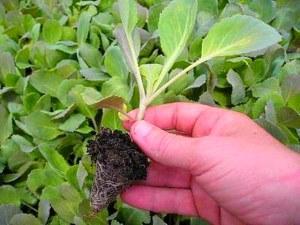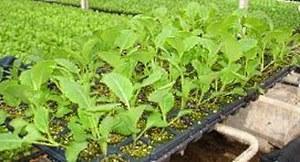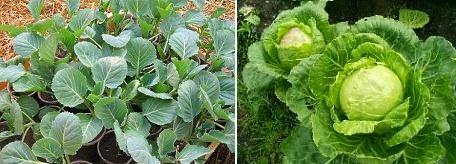How to grow cabbage seedlings yourself?
 The process for growing cabbage seedlings is almost identical for all cabbage varieties. This article will consider an example of growing white cabbage seedlings.
The process for growing cabbage seedlings is almost identical for all cabbage varieties. This article will consider an example of growing white cabbage seedlings.
In terms of ripening and time, it can be divided into:
- Early maturing (sown in the first half of March);
- Mid-season (sown from March 15 to April 15);
- Late ripening (sown in the first half of April).
How to sow cabbage for seedlings?
For planting cabbage seeds for seedlings, a soil mixture is recommended, which consists of one part of sod land and two parts of humus. It is recommended to add ash to this mixture, based on 1 kg of the mixture 1 tablespoon of ash. This enriches the soil with additional trace elements and prevents the appearance of some seedling diseases.

Seeds are carefully selected before sowing. Cabbage seeds are poured with 3% sodium chloride solution for 5 minutes. The floating seeds are merged with water, and the rest are thoroughly washed and dried. For sowing, seeds of a large and medium fraction are selected.
Planting cabbage for seedlings is done with disinfected seeds. From pathogens, seeds can be disinfected with a solution of potassium permanganate, and then rinsed with water. But such processing gives a small percentage of probability. A greater effect can be achieved with heat treatment. For this, the seeds are placed in a gauze bag and immersed in hot water for 20 minutes. The water temperature should be within 48-50aboutC, since at lower temperatures, the desired effect will be lost, and at higher temperatures, the seeds may lose their germination.
There is another way to disinfect seeds: they are kept in a garlic solution (30 g of crushed garlic is dissolved in 0.5 glass of water) for one hour. After that, the seeds must be rinsed with clean water and dried thoroughly.
The packaging of the seeds may indicate that they have already passed the necessary processing. In this case, it is necessary to carry out only heat treatment, which is necessary to increase the resistance of the seeds to fungal diseases.
Seeds are planted in boxes 20 * 30 * 7. In the soil, grooves up to 0.7 cm deep are squeezed at a distance of 3 cm from each other. Seeds are sown into these grooves. After sowing, the soil surface is leveled and covered with foil. The first shoots appear on the fourth day after sowing. It is recommended to display boxes with seedlings in the most illuminated places.
The main methods of growing seedlings
There are two common ways to grow cabbage seedlings:
- The first way... As soon as shoots appear, the seedlings are discharged (excess shoots are removed). The distance between the remaining seedlings is 1.5 cm.A week later, the remaining shoots are transplanted (dived) into cassettes (wooden or plastic) with 3 x 3 cm cells... When picking, the plant must be deepened into the ground until the cotyledonous leaves. After 2-3 weeks, the seedlings from the cassettes are transplanted into cups, the size of which is 6 * 6 cm. The sprouts are removed from the cassettes with a lump of earth, after which they are placed in cups until the cotyledon leaves and sprinkled with soil.The last stage will be the transplanting of seedlings directly into the ground.
- Second way... Cabbage seedlings from boxes are transplanted directly into cups, bypassing the stage of transplanting into cassettes. The size of the cups for early maturing seedlings is 5 * 5 cm, and for late maturing - 8 * 8 cm. When transplanting, the main root must be cut by 1/3 of the length. This is necessary in order for the root system to be better branched. The sprouts are buried in the cups to the cotyledonous leaves with the help of a lance.
Growing early cabbage seedlings
For growing seedlings of early cabbage, you must follow some rules.
Seedling feeding must be carried out in three stages:
- After 7 days from the moment of picking into cassettes. Based on 1 liter of water, 2 g of ammonium nitrate, 4 g of superphosphate, 1 g of potassium fertilizers are dissolved.
- After two weeks have passed since the first feeding. The dosage of the components is doubled.
- Two days before planting seedlings in permanent soil. At this point, the seedlings already have a developed root system and 6-8 true leaves. For 1 liter of water, 2 g of ammonium nitrate, 4 g of superphosphate, 6-8 g of potassium fertilizers are dissolved.
Watering seedlings is carried out in moderation. Excessive soil moisture should not be allowed.

To obtain healthy sprouts of cabbage, it is necessary to provide it with a 14-16 hour light regime. Depending on how much power the artificial lighting lamps have, they are located at a distance of 10 to 50 cm from the seedlings (as the plants grow, the distance must be adjusted). The recommended turn-on time for artificial lighting lamps is from 8 am to 11 pm.
For the friendly germination of seedlings and plant development, the following thermal regime must be observed:
- Before the first shoots appear - 18-20 aboutFROM;
- Sprouted seeds - sunny day 15-17 aboutС, cloudy day 13-15 aboutС, at night 7-10 aboutFROM;
Caring for cabbage seedlings at home practically does not differ from standard measures. Before the seedlings are planted in permanent soil, they must be hardened two weeks before the intended transplant. In the first stages, the plants are gradually accustomed to cold air, for which the vents are opened.
At the second stage, the plants are taken out to the balcony for 2-3 hours in the daytime, but protecting the seedlings from direct sunlight. Gradually, the time increases, and the protection from the sun's rays is removed. When hardening, seedlings are practically not watered. At the last stage of hardening, if the night temperature exceeds 2-3 aboutC, the seedlings are left in the fresh air for the night, previously covered with a film stretched over the frame.
Planting seedlings in permanent soil
Planting seedlings in permanent soil is carried out:
- For early maturing varieties - late April-early May;
- For mid-season varieties - late May - early June;
- For late-ripening varieties - mid-May.
It should be remembered that cabbage is very susceptible to cold, therefore it is recommended to cover it at night. After planting, the first days of seedlings must be covered from direct sunlight.
A very instructive article. I especially liked the place where it is described how to prepare cabbage seeds for sowing into the soil. I have been growing cabbage seedlings for many years, but I have not done any preparatory work with the seeds. This year I will definitely soak the seeds in a solution of salt and process them with potassium permanganate as written in the article. I sow cabbage seeds directly into a mini-greenhouse, I must feed them several times (approximately as described in the article). I always have a good harvest of cabbage. The only problem is that sometimes geese can be found in cabbage leaves. Maybe someone knows how to deal with it?